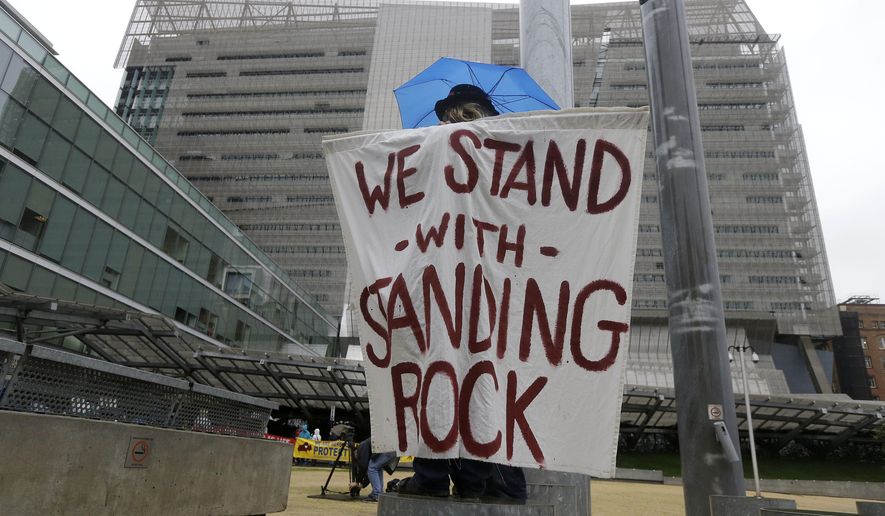The Standing Rock Sioux tribe doesn’t want activists returning to protest the Trump administration’s decision to proceed with the Dakota Access pipeline. The activists, however, have other ideas.
Several protest leaders called Wednesday for the pipeline demonstrators to come back to the campsite near Cannon Ball, North Dakota, even as the tribe undertakes a massive cleanup to remove the mounds of trash and debris left by the thousands of activists who occupied the region last year.
Chase Iron Eyes, a protest leader and North Dakota’s 2016 Democratic candidate for Congress, called on foes of the 1,172-mile, four-state pipeline to join the several hundred activists still camped out in southern North Dakota.
“Other tribal governments are weighing in and supporting a fight on the ground as they have a right to do,” Mr. Iron Eyes said Wednesday on “Democracy Now!” “There are 400 to 500 people north of the Cannon Ball River in the contested zone, in the treaty zone, in the place where, according to the United States Army Corps of Engineers, we are not supposed to be. And they are going to stand their ground.”
He said anti-pipeline veterans and others are already making their way back to the protest site.
“There are already people en route to join this peaceful, prayerful, nonviolent exercise of our human treaty, constitutional and civil rights, which are at stake,” Mr. Iron Eyes said.
Another wave of protesters could disrupt efforts by the Standing Rock Sioux to remove the acres of trash left over from the last protest, which Morton County emergency manager Tom Doering has estimated at about 250 truckloads.
The cleanup area is located on U.S. Army Corps of Engineers land in the Cannonball River floodplain. Any leftover tents, teepees, sleeping bags, blankets, waste and other debris would be washed into the river during the spring snowmelt, creating an environmental hazard.
The U.S. Army Corps of Engineers, which has ordered protesters to evacuate the land by Feb. 22, said Tuesday in letters to Congress that the final easement would be granted for the 1,172-mile, four-state pipeline, which is about 99 percent completed.
The easement, which was granted in July but withdrawn in December by the Obama administration, would allow Energy Transfer Partners to finish the $3.8 billion project’s last 1,100-foot segment under Lake Oahe in North Dakota.
North Dakota’s Sen. John Hoeven and Rep. Kevin Cramer issued statements Wednesday saying the easement was issued.
The action clears the way for completion of the disputed $3.8 billion project. But the Standing Rock Sioux tribe has promised to challenge it in court.
The tribe has fought approval of the final stretch, which falls about a half-mile from the reservation, over concerns about water quality. The company has insisted that the pipeline, almost all of which is located on private land, is safe.
In a Tuesday video on the Sacred Stone Camp’s Facebook page, an activist who goes by Johnny Dangers called on protesters to return to southern North Dakota.
“We all have to walk a path like the one you see in front of us. It leads different places for different people, but I hope some of you will take this path that leads you here to stand up with us on this final stand against the black snake,” said Mr. Dangers from the camp.
LaDonna Allard, a Standing Rock Sioux member who leads the Sacred Stone Camp, an encampment located on her private land, also wanted protesters to come back, he said.
“Those of you that stood, we call you back to stand again,” Mr. Dangers said. “LaDonna has called you back to stand again. Sacred Stone has called you back to stand again.”
Foes of the pipeline held a half-dozen demonstrations Wednesday, including one in front of the White House, in order to protest the easement’s approval.
“Today begins the next phase of mass resistance to Donald Trump’s toxic Dakota Access Pipeline,” said Dallas Goldtooth, Indigenous Enviromental Network executive director. “This is our land, our water, our health and our culture at stake — and if Donald Trump thinks we will give all of that up without a fight, he is wrong.”
Mr. Trump told reporters Tuesday that there was no outcry after he signed last month executive orders expediting the Dakota Access and Keystone XL pipelines, prompting pipeline opponents to launch a phone-call campaign to the White House.
“As you know I approved two pipelines that were stuck in limbo forever. I don’t even think it was controversial. You know, I approved them and I haven’t even heard one call from anybody saying, ’Oh, that was a terrible thing you did,’” Mr. Trump said in the [U.K.] Independent.
Standing Rock Sioux Chairman Dave Archambault has asked pipeline foes to steer clear and instead attend a March 10 march on Washington, D.C., but Mr. Iron Eyes said that the tribe and protesters disagree on strategy.
“I know there is a difference of opinion, but we stand united with the Standing Rock nation in wanting the most highly militarized blockade in North Dakota history to be lifted, because it’s functioning as a successful economic sanction,” Mr. Iron Eyes said.
• Valerie Richardson can be reached at vrichardson@washingtontimes.com.




Please read our comment policy before commenting.